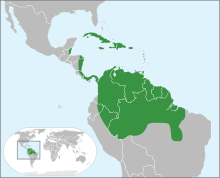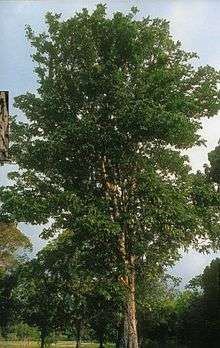Carapa guianensis
Carapa guianensis is a species of tree in the family Meliaceae, also known by the common names andiroba or crabwood.

| Carapa guianensis | |
|---|---|
 | |
| Scientific classification | |
| Kingdom: | Plantae |
| Clade: | Tracheophytes |
| Clade: | Angiosperms |
| Clade: | Eudicots |
| Clade: | Rosids |
| Order: | Sapindales |
| Family: | Meliaceae |
| Genus: | Carapa |
| Species: | C. guianensis |
| Binomial name | |
| Carapa guianensis | |
Description
Andiroba is native to the Amazon and is widely used by the indigenous populations of the northern region of Brazil.[1] It grows in the Amazon region, Central America and the Caribbean. It is a tall tree with dense foliage and usually grows in the tropical rainforest along the edge of rivers.
Uses
The timber is used in furniture and flooring. While the wood is not classified as genuine mahogany, it is related to the mahogany family and is similar in appearance.[2]
The oil contained in the andiroba almond, known as crab oil or carap oil, is light yellow and extremely bitter. When subjected to a temperature below 25 °C, it solidifies, with a consistency like that of petroleum jelly. It contains olein, palmitin and glycerin.
The oil and fats of the almond are extracted and used for the production of insect repellent and compounds for traditional medicine.[1][3][4][5] It is used in Brazil to protect furniture from termites and other wood-chewing insects.
References
- Hammer, M. L.; Johns, E. A. (1993). "Tapping an Amazônian plethora: Four medicinal plants of Marajó Island, Pará (Brazil)". Journal of Ethnopharmacology. 40 (1): 53–75. doi:10.1016/0378-8741(93)90089-n. PMID 8246531.
- Andiroba - Wood database
- Roy, A; Saraf, S (2006). "Limonoids: Overview of significant bioactive triterpenes distributed in plants kingdom". Biological & Pharmaceutical Bulletin. 29 (2): 191–201. doi:10.1248/bpb.29.191. PMID 16462017.
- De Mendonça, F. A.; Da Silva, K. F.; Dos Santos, K. K.; Ribeiro Júnior, K. A.; Sant'Ana, A. E. (2005). "Activities of some Brazilian plants against larvae of the mosquito Aedes aegypti". Fitoterapia. 76 (7–8): 629–36. doi:10.1016/j.fitote.2005.06.013. PMID 16253435.
- Silva, O. S.; Romão, P. R.; Blazius, R. D.; Prohiro, J. S. (2004). "The use of andiroba Carapa guianensis as larvicide against Aedes albopictus". Journal of the American Mosquito Control Association. 20 (4): 456–7. PMID 15669392.